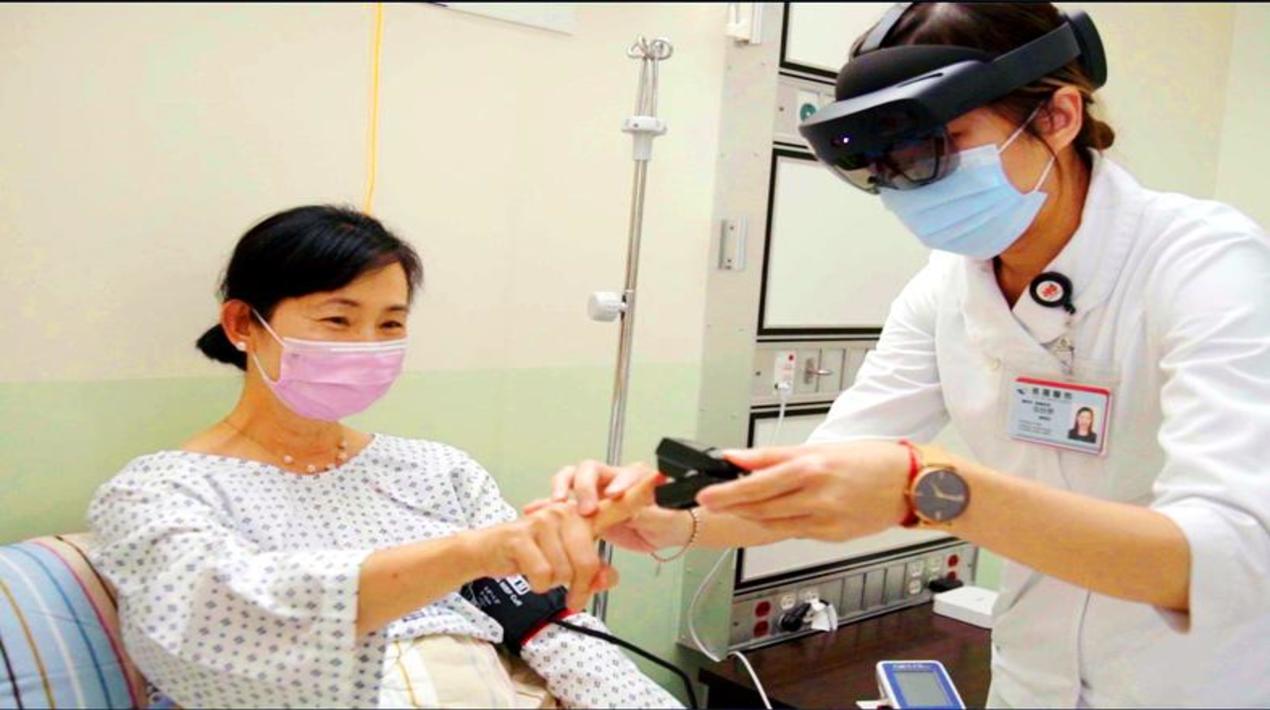
National Taiwan University Hospital (NTUH), the Taoyuan City Government and local technology companies unveiled a blood oxygen monitor platform and mixed reality headsets to help medical workers combat silent hypoxia in COVID-19 patients. The equipment that was developed to facilitate “zero contact” treatment methods and reduce hypoxia deaths, would be deployed in six municipal quarantine facilities.
One-third of COVID-19 patients with mild or moderate symptoms might experience rapidly deteriorating health conditions in the late stages of the disease. This makes early detection of health downturns crucial. However, the deployment of manual vital sign monitors puts medical workers at increased risk of contracting the disease. Moreover, getting repeatedly in and out of personal protective equipment also causes fatigue.
The new real-time blood oxygen monitoring platform utilises Artificial Intelligence (AI) and is equipped with a thermometer and blood oxygen and blood pressure measuring devices. The platform automatically alerts medical personnel when a patient’s blood oxygen concentration drops to 95% of normal levels, which makes rapid medical intervention necessary.
The mixed-reality sick room system uses headsets to Livestream patient images to doctors, who can assess their condition through the teleconference software. The program then collects and applies big data analytics to patients’ vital signs. This would help medical workers assess disease risks and warn doctors of complications before they occur.
Intelligent medicine helps hospitals detect complications accurately with fewer personnel and can even benefit preventive care. The equipment is expected to reduce medical staff’s exposure to COVID-19 and lead to significant care quality improvements under pandemic conditions. Taoyuan City and Taoyuan General Hospital collaborated on the project because the city, as a national gateway, is in a good position to impede the virus.
Digital health has great potential to transform healthcare in Taiwan through delivering a better patient experience, with improved results, at lower costs. This trend is attracting the growing attention of firms operating at the intersection of technology and medical science, as well as encouraging tie-ups and collaborations between medical facilities and businesses involved in innovative sectors such as AI and the Internet of Things.
In Taiwan, the digital health trend is attracting the growing attention of businesses and new start-ups operating at the intersection of technology and medical science. Renowned hi-tech companies aim to transform not only Taiwan’s healthcare system but also the world’s. The focus is on integrating advanced technologies with the latest medical applications to enable connected and smart healthcare. This development is expected to have a synergistic impact on Taiwan’s emerging biomedical industry.
As the COVID-19 pandemic accelerated the transformation of information technology in the medical sector, Taiwan has been inventing many advanced technologies to prevent the further spread of COVID-19 infections. As reported by OpenGov Asia, Industrial Technology Research Institute (ITRI) utilised thermal Image Body Temperature Detection Technology together with AI and infrared thermal image colour displays to enable the detection of forehead temperatures for multiple individuals concurrently.
Supported by Taiwan’s Ministry of Economic Affairs (MOEA), the technology offers a non-contact, high-precision, full-colour detection solution that can improve contact tracing and thus contain the spread of COVID-19. The new feature of colour imagery greatly improves entry and exit controls, addressing the needs of government agencies and private companies that have large numbers of people passing through their doors.
In practice, ITRI has helped companies integrate the body temperature detection system with the company’s employee ID data for the access control at its Hsinchu facility. This also meets the requirements of the real-name system by the Central Epidemic Command Center, while reducing monitoring time and manpower needs by over two-thirds compared to manual temperature measurement.
ITRI’s Thermal Image Body Temperature Detection Technology combines AI to enable automated detection of forehead temperatures, avoiding errors caused by interference from other heat sources. Temperature compensation technology is utilised in conjunction with the Internet of Things (IoT) to sense the distance between detection device and heat source, along with ambient temperature and humidity levels.




















